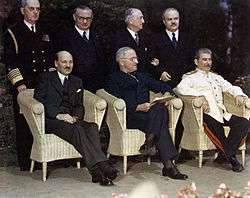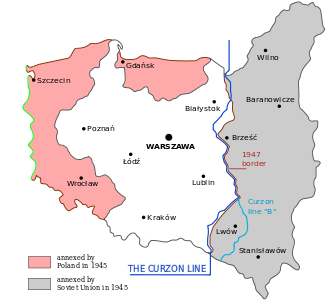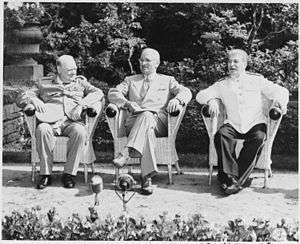Potsdam Conference




The Potsdam Conference (German: Potsdamer Konferenz) was held at Cecilienhof, the home of Crown Prince Wilhelm, in Potsdam, occupied Germany, from 17 July to 2 August 1945. (In some older documents it is also referred to as the Berlin Conference of the Three Heads of Government of the USSR, USA and UK.[2][3]) Participants were the Soviet Union, the United Kingdom and the United States. The three powers were represented by Communist Party General Secretary Joseph Stalin, Prime Ministers Winston Churchill[4] and, later, Clement Attlee,[5] and President Harry S. Truman.
Stalin, Churchill, and Truman—as well as Attlee, who participated alongside Churchill while awaiting the outcome of the 1945 general election, and then replaced Churchill as Prime Minister after the Labour Party's defeat of the Conservatives—gathered to decide how to administer the defeated Nazi Germany, which had agreed to unconditional surrender nine weeks earlier, on 8 May (V-E Day). The goals of the conference also included the establishment of post-war order, peace treaty issues, and countering the effects of the war.
Relationships amongst the leaders
In the five months since the Yalta Conference, a number of changes had taken place which would greatly affect the relationships between the leaders.
1. The Soviet Union was occupying Central and Eastern Europe
By July, the Red Army effectively controlled the Baltic states, Poland, Czechoslovakia, Hungary, Bulgaria and Romania, and fearing a Stalinist take-over, refugees were fleeing from these countries. Stalin had set up a communist government in Poland. He insisted that his control of Eastern Europe was a defensive measure against possible future attacks and claimed that it was a legitimate sphere of Soviet influence.[6]
2. Britain had a new Prime Minister
The results of the British election became known during the conference. As a result of the Labour Party victory over the Conservative Party the leadership changed hands. Consequently, British Prime Minister Clement Attlee assumed leadership following Winston Churchill, whose Soviet policy since the early 1940s had differed considerably from former US President Roosevelt's, with Churchill believing Stalin to be a "devil"-like tyrant leading a vile system.[7]
3. The United States had a new president, and the war was ending
President Roosevelt had died on 12 April 1945, and Vice-President Harry Truman assumed the presidency; his succession saw VE Day (Victory in Europe) within a month and VJ Day (Victory in Japan) on the horizon. During the war and in the name of Allied unity, Roosevelt had brushed off warnings of a potential domination by a Stalin dictatorship in part of Europe. He explained that "I just have a hunch that Stalin is not that kind of a man," and reasoned, "I think that if I give him everything I possibly can and ask for nothing from him in return, 'noblesse oblige,' he won't try to annex anything and will work with me for a world of democracy and peace."[8]
While inexperienced in foreign affairs, Truman had closely followed the allied progress of the war. George Lenczowski notes "despite the contrast between his relatively modest background and the international glamour of his aristocratic predecessor, [Truman] had the courage and resolution to reverse the policy that appeared to him naive and dangerous," which was "in contrast to the immediate, often ad hoc moves and solutions dictated by the demands of the war."[9] With the end of the war, the priority of allied unity was replaced with a new challenge, the nature of the relationship between the two emerging superpowers.[9]
Truman became much more suspicious of communist moves than Roosevelt had been, and he became increasingly suspicious of Soviet intentions under Stalin.[9] Truman and his advisers saw Soviet actions in Eastern Europe as aggressive expansionism which was incompatible with the agreements Stalin had committed to at Yalta the previous February. In addition, it was at the Potsdam Conference that Truman became aware of possible complications elsewhere, when Stalin objected to Churchill's proposal for an early Allied withdrawal from Iran, ahead of the schedule agreed at the Tehran Conference. However, the Potsdam Conference marks the first and only time Truman would ever meet Stalin in person.[10][11]
Agreements made between the leaders at Potsdam
Potsdam Agreements


At the end of the conference, the three Heads of Government agreed on the following actions. All other issues were to be answered by the final peace conference to be called as soon as possible.
Indochina
Allied Chiefs of Staff at the Potsdam Conference decided to temporarily partition Vietnam at the 16th parallel (just North of Da Nang) for the purposes of operational convenience.
It was agreed that British forces would take the surrender of Japanese forces in Saigon for the southern half of Indochina, whilst Japanese troops in the northern half would surrender to the Chinese.
Germany
- Issuance of a statement of aims of the occupation of Germany by the Allies: demilitarization, denazification, democratization, decentralization and decartelization.
- Division of Germany and Austria respectively into four occupation zones (earlier agreed in principle at Yalta), and the similar division of each capital, Berlin and Vienna, into four zones.
- Agreement on the prosecution of Nazi war criminals.
- Reversion of all German annexations in Europe, including Sudetenland, Alsace-Lorraine, Austria, and the westernmost parts of Poland
- Germany's eastern border was to be shifted westwards to the Oder–Neisse line, effectively reducing Germany in size by approximately 25% compared to its 1937 borders. The territories east of the new border comprised East Prussia, Silesia, West Prussia, and two thirds of Pomerania. These areas were mainly agricultural, with the exception of Upper Silesia which was the second largest centre of German heavy industry.
- "Orderly and humane" expulsions of the German populations remaining beyond the new eastern borders of Germany; from Poland, Czechoslovakia and Hungary, but not Yugoslavia.[12]
- Agreement on war reparations to the Soviet Union from their zone of occupation in Germany. It was also agreed that 10% of the industrial capacity of the western zones unnecessary for the German peace economy should be transferred to the Soviet Union within 2 years. Stalin proposed and it was accepted that Poland was to be excluded from division of German compensation to be later granted 15% of compensation given to Soviet Union.
- Ensuring that German standards of living did not exceed the European average. The types and amounts of industry to dismantle to achieve this was to be determined later (see Allied plans for German industry after World War II).
- Destruction of German industrial war-potential through the destruction or control of all industry with military potential. To this end, all civilian shipyards and aircraft factories were to be dismantled or otherwise destroyed. All production capacity associated with war-potential, such as metals, chemical, machinery etc. were to be reduced to a minimum level which was later determined by the Allied Control Commission. Manufacturing capacity thus made "surplus" was to be dismantled as reparations or otherwise destroyed. All research and international trade was to be controlled. The economy was to be decentralized (decartelization). The economy was also to be reorganized with primary emphasis on agriculture and peaceful domestic industries. In early 1946 agreement was reached on the details of the latter: Germany was to be converted into an agricultural and light industry economy. German exports were to be coal, beer, toys, textiles, etc. — to take the place of the heavy industrial products which formed most of Germany's pre-war exports.[13]
Poland

- A Provisional Government of National Unity recognized by all three powers should be created (known as the Lublin Poles). When the Big Three recognized the Soviet controlled government, it meant, in effect, the end of recognition for the existing Polish government-in-exile (known as the London Poles).
- Poles who were serving in the British Army should be free to return to Poland, with no security upon their return to the communist country guaranteed.
- The provisional western border should be the Oder–Neisse line, defined by the Oder and Neisse rivers. Parts of East Prussia and the former Free City of Danzig should be under Polish administration. However the final delimitation of the western frontier of Poland should await the peace settlement (which would take place 45 years later at the Treaty on the Final Settlement with Respect to Germany in 1990)
- The Soviet Union declared it would settle the reparation claims of Poland from its own share of the overall reparation payments.
Potsdam Declaration



In addition to the Potsdam Agreement, on 26 July, Churchill, Truman, and Chiang Kai-shek, Chairman of the Nationalist Government of China (the Soviet Union was not at war with Japan) issued the Potsdam Declaration which outlined the terms of surrender for Japan during World War II in Asia.
Aftermath
Truman had mentioned an unspecified "powerful new weapon" to Stalin during the conference. Towards the end of the conference, Japan was given an ultimatum to surrender (in the name of the United States, Great Britain and China) or meet "prompt and utter destruction", which did not mention the new bomb. Prime minister Kantarō Suzuki did not respond[14] (mokusatsu, which was interpreted as a declaration that the Empire of Japan should ignore the ultimatum). Therefore, the United States dropped atomic bombs on Hiroshima on August 6 and Nagasaki on August 9, 1945. The justification was that both cities were legitimate military targets, to end the war swiftly, and preserve American lives. However, to some the timing has suggested that Truman did not want Stalin involved in the terms of Japan's surrender. It is important to note that Truman delayed the Potsdam Conference in order to be sure of the functionality of this "powerful new weapon." Notably, when Truman informed Stalin of the atomic bomb, he did not explicitly mention its atomic nature, just vaguely saying that the United States “had a new weapon of unusual destructive force”;[15] Stalin, though, had full knowledge of the atomic bomb's development due to Soviet spy networks inside the Manhattan Project, and told Truman at the conference to "make good use of this new addition to the Allied arsenal".[16]
The Soviet Union converted the other countries of eastern Europe into Soviet Satellite states within the Eastern Bloc, such as the People's Republic of Poland, the People's Republic of Bulgaria, the People's Republic of Hungary,[17] the Czechoslovak Republic,[18] the People's Republic of Romania,[19] and the People's Republic of Albania.[20] The Soviets later formed the puppet state of East Germany (officially The German Democratic Republic) from the Soviet zone of German occupation.[21]
Previous major conferences
- Yalta Conference, 4 to 11 February 1945
- Second Quebec Conference, 12 to 16 September 1944
- Tehran Conference, 28 November to 1 December 1943
- Cairo Conference, 22 to 26 November 1943
- Casablanca Conference, 14 to 24 January 1943
See also
Notes
- ↑ Description of photograph, Truman Library.
- ↑ "Avalon Project - A Decade of American Foreign Policy 1941-1949 - Potsdam Conference". Avalon.law.yale.edu. Retrieved 20 March 2013.
- ↑ Russia (USSR) / Poland Treaty (with annexed maps) concerning the Demarcation of the Existing Soviet-Polish State Frontier in the Sector Adjoining the Baltic Sea 5 March 1957 (retrieved from the UN Delimitation Treaties Infobase, accessed on 18 March 2002)
- ↑ "Potsdam-Conference" Encyclopædia Britannica
- ↑ "BBC Fact File: Potsdam Conference". Bbc.co.uk. 2 August 1945. Retrieved 20 March 2013.
- ↑ Leffler, Melvyn P., "For the South of Mankind: The United States, the Soviet Union and the Cold War, First Edition, (New York, 2007) pg 31
- ↑ Miscamble 2007, p. 51
- ↑ Miscamble 2007, p. 52
- 1 2 3 George Lenczowski, American Presidents and the Middle East, (1990), pp7-13
- ↑ Harry S. Truman, Memoirs, Vol. 1: Year of Decisions (1955), p.380, cited in Lenczowski, American Presidents, p.10
- ↑ Nash, Gary B. "The Troublesome Polish Question." The American People: Creating a Nation and a Society. New York: Pearson Longman, 2008. Print.
- ↑ Alfred de Zayas Nemesis at Potsdam, Routledge, London 1977. See also conference on "Potsdamer Konferenz 60 Jahre danach" hosted by the Institut für Zeitgeschichte in Berlin on 19. August 2005 PDF Seite 37 et seq.
- ↑ James Stewart Martin. All Honorable Men (1950) p. 191.
- ↑ "Mokusatsu: One Word, Two Lessons" (PDF). Retrieved 20 March 2013.
- ↑ Putz, Catherine (18 May 2016). "What If the United States Had Told the Soviet Union About the Bomb?". The Diplomat. Retrieved 8 July 2016.
- ↑ Nichols, Tom (12 April 2016). "Simply No Other Choice: Why America Dropped the Atomic Bomb on Japan". National Interest.org. Retrieved 21 April 2016.
- ↑ Granville, Johanna, The First Domino: International Decision Making during the Hungarian Crisis of 1956, Texas A&M University Press, 2004. ISBN 1-58544-298-4
- ↑ Grenville 2005, pp. 370–71
- ↑ The American Heritage New Dictionary of Cultural Literacy, Third Edition. Houghton Mifflin Company, 2005.
- ↑ Cook 2001, p. 17
- ↑ Wettig 2008, pp. 96–100
References
- Cook, Bernard A. (2001), Europe Since 1945: An Encyclopedia, Taylor & Francis, ISBN 0-8153-4057-5
- Crampton, R. J. (1997), Eastern Europe in the twentieth century and after, Routledge, ISBN 0-415-16422-2
- Miscamble, Wilson D. (2007), From Roosevelt to Truman: Potsdam, Hiroshima, and the Cold War, Cambridge University Press, ISBN 0-521-86244-2
- Roberts, Geoffrey (2002), Stalin, the Pact with Nazi Germany, and the Origins of Postwar Soviet Diplomatic Historiography, 4 (4)
- Wettig, Gerhard (2008), Stalin and the Cold War in Europe, Rowman & Littlefield, ISBN 0-7425-5542-9
Further reading
- Michael Beschloss. The Conquerors: Roosevelt, Truman, and the destruction of Hitler's Germany, 1941-1945 (Simon & Schuster, 2002) ISBN 0684810271
- Farquharson, J. E. "Anglo-American Policy on German Reparations from Yalta to Potsdam." English Historical Review 1997 112(448): 904–926. in JSTOR
- Feis, Herbert. Between War and Peace: The Potsdam Conference (Princeton University Press, 1960) OCLC 259319
- Gimbel, John. "On the Implementation of the Potsdam Agreement: an Essay on U.S. Postwar German Policy." Political Science Quarterly 1972 87(2): 242–269. in JSTOR
- Gormly, James L. From Potsdam to the Cold War: Big Three Diplomacy, 1945–1947. (Scholarly Resources, 1990)
- Mee, Charles L., Jr. Meeting at Potsdam. M. Evans & Company, 1975. ISBN 0871311674
- Naimark, Norman. Fires of Hatred. Ethnic Cleansing in Twentieth-Century Europe (Harvard University Press, 2001) ISBN 0674003136
- Neiberg, Michael. Potsdam: the End of World War II and the Remaking of Europe (Basic Books, 2015) ISBN 9780465075256
- Thackrah, J. R. "Aspects of American and British Policy Towards Poland from the Yalta to the Potsdam Conferences, 1945." Polish Review 1976 21(4): 3–34. in JSTOR
- Zayas, Alfred M. de. Nemesis at Potsdam: The Anglo-Americans and the Expulsion of the Germans, Background, Execution, Consequences. Routledge, 1977. ISBN 0710004583
Primary sources
- Foreign Relations of the United States: Diplomatic Papers. The Conference of Berlin (Potsdam Conference, 1945) 2 vols. Washington, D.C.: U.S. Government Printing Office, 1960
External links
| Wikimedia Commons has media related to Potsdam Conference. |
- Truman and the Potsdam Conference
- Annotated bibliography for the Potsdam Conference from the Alsos Digital Library
- The Potsdam Conference, July – August 1945 on navy.mil
- United States Department of State Foreign relations of the United States : diplomatic papers : the Conference of Berlin (the Potsdam Conference) 1945 Volume I Washington, D.C.: U.S. Government Printing Office, 1945
- United States Department of State Foreign relations of the United States : diplomatic papers : the Conference of Berlin (the Potsdam Conference) 1945 Volume II Washington, D.C.: U.S. Government Printing Office, 1945
- European Advisory Commission, Austria, Germany Foreign relations of the United States : diplomatic papers, 1945.
- Harry Truman Revisionist Analysis of Potsdam Conference Shapell Manuscript Foundation
- Cornerstone of Steel, Time magazine, 21 January 1946
- Cost of Defeat, Time magazine, 8 April 1946
- Pas de Pagaille! Time magazine, 28 July 1947
- Agreements of the Berlin (Potsdam) Conference
- Interview with James W. Riddleberger Chief, Division of Central European Affairs, U.S. Dept. of State, 1944–47
- "The Myth of Potsdam," in B. Heuser et al., eds., Myths in History (Providence, Rhode Island and Oxford: Berghahn, 1998)
- "The United States, France, and the Question of German Power, 1945–1960," in Stephen Schuker, ed., Deutschland und Frankreich vom Konflikt zur Aussöhnung: Die Gestaltung der westeuropäischen Sicherheit 1914–1963, Schriften des Historischen Kollegs, Kolloquien 46 (Munich: Oldenbourg, 2000).
- U.S. Economic Policy Towards defeated countries April 1946.
- Lebensraum
- EDSITEment's lesson Sources of Discord, 1945-1945
